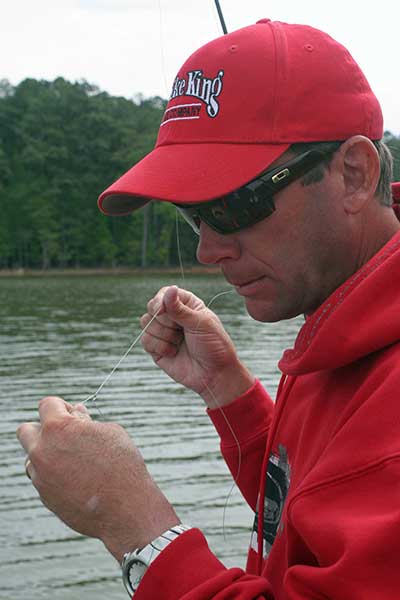By Kevin VanDam
 Cost-effective Tips for Maintaining Fresh Line
Cost-effective Tips for Maintaining Fresh Line
If you don’t want a broken heart this summer, don’t neglect your fishing line - re-spool often to avoid those break-offs when a big fish bites.
The key to remember is use FRESH line that has been stored properly and hasn’t broken down. Buy from a retailer that sells a lot of line and not someone who has old stuff that may have begun to deteriorate.
It’s equally important to stick to a brand that you have confidence in or familiarity.
I’ve used Bass Pro XPS since I started my career. Because of that familiarity, I am intimately familiar with its diameter, performance and tolerance with each technique I use. If you use a variety of brands, you won’t know what’s on each reel and won’t gain the same kind of confidence.
Fluorocarbon and braid – immensely popular with bass anglers – can get expensive when spooling up an entire arsenal. However, if you’re willing to spend a few more bucks on bulk spools, you will get more for your money.
Here’s an example. Michigan anglers use a lot of spinning tackle and go through a ton of 8-pound fluorocarbon line. When spooling with a 250-yard filler spool, you wind up with 25-50 yards leftover and often throw it away. With a bulk spool, you can fill 10 times and manage how much is wasted.
So if there’s a line size and type you use often, bulk spools are less expensive in the long run.
Should you replace last year’s line that appears in good order? That depends upon how much you fished last year and the techniques you used.
I leave nothing to chance which is why I add fresh line each night on rods I used during that day. But I don’t remove all of my line.
For example, if I spent the day cranking a 6XD, I know that part of the line has been stretched and abused. That night, I will strip off 75-100 yards and tie on new line. Now, if I spent the day fishing shaky head jigs around boat docks, I may only strip off 20 or 30 yards.
To determine how much to add, walk off what you think would be your longest cast and add another 20 to 30 yards before you cut the line.
Braid doesn’t have to be changed as often, but it will lose its potency after a while. A good way to tell is if you notice it’s starting to fuzz up or lose its original color.
If that’s the case, here’s how to get more mileage out of it; reverse it. In other words, strip it off the reel in an organized manner then reattach it with the end you’ve been fishing with tied onto the spool. Once you do, the end that had been unused will be as fresh as it was when you got it.
I rarely strip my line down to the spool. I always use old backing and attach fresh line with an Albright knot. And if I get a new reel, I will use old line from another reel as backing before adding new line. I also put a piece of electrical tape on the backing so the next time I strip off line to add fresh, I know that’s the place to start.
Years ago I helped develop the KVD Line and Lure Conditioner spray.
Initially, we used it to add casting distance on monofilament or fluorocarbon and reduce the loops and snarls that can occur.
I’ve since discovered the conditioner is excellent for protecting the coatings that come on braided lines and give the braid longer life. When winding on any new line, I will wind up about 20 yards, spray, then wind on another 20 yards and so on. I also spray my spooled reels the night before I fish with them.
Don’t ever cheat yourself on line by trying save a few bucks. That big fish of a lifetime is out there waiting on you, and you have to be prepared when he bites.


